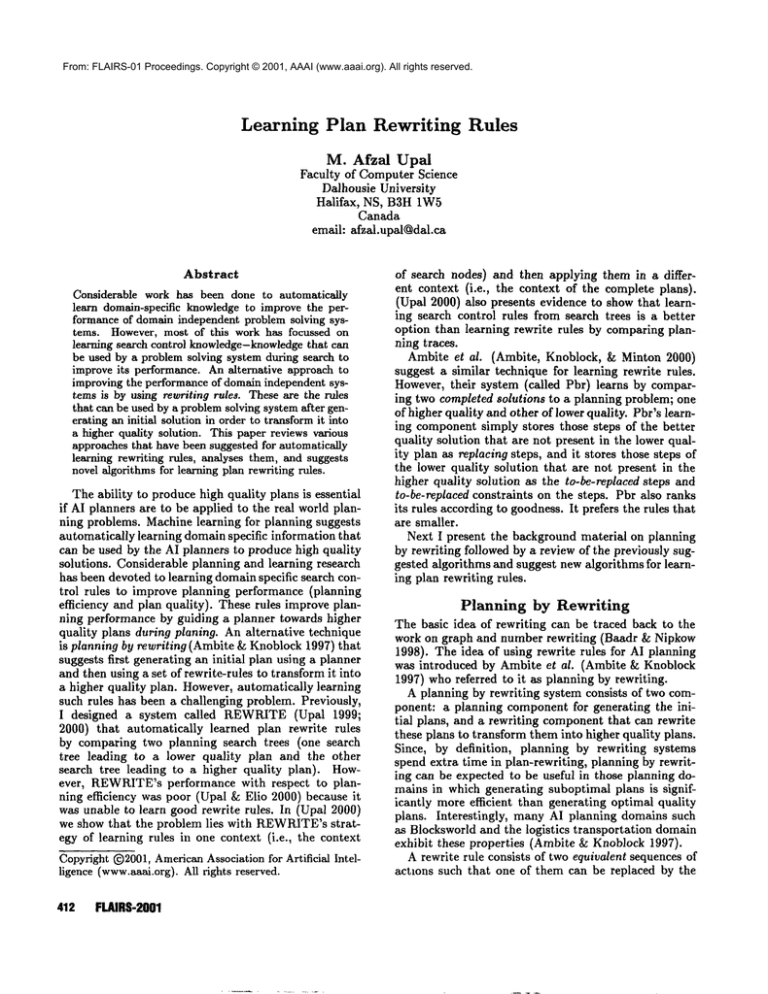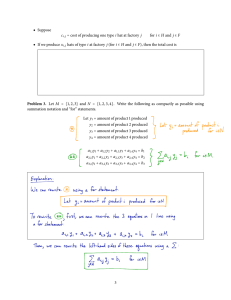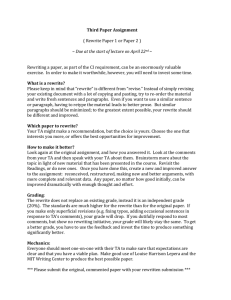
From: FLAIRS-01 Proceedings. Copyright © 2001, AAAI (www.aaai.org). All rights reserved.
Learning Plan Rewriting
Rules
M. Afzal
Upal
Faculty of Computer Science
Dalhousie University
Halifax, NS, B3H1W5
Canada
emaih afzal.upal@dal.ca
Abstract
Considerable work has been done to automatically
learn domain-specific knowledgeto improve the performance of domainindependent problem solving systems. However, most of this work has focussed on
learning search control knowledge-knowledge
that can
be used by a problem solving system during search to
improve its performance. Analternative approach to
improving the performance of domainindependent systems is by using rewriting rules. Theseare the rules
that can be used by a problemsolving systemafter generating an initial solution in order to transformit into
a higher quality solution. This paper reviews various
approachesthat have been suggested for automatically
learning rewriting rules, analyses them, and suggests
novel algorithms for learning plan rewriting rules.
The ability to produce high quality plans is essential
if AI planners are to be applied to the real world planning problems. Machine learning for planning suggests
automatically learning domainspecific information that
can be used by the AI planners to produce high quality
solutions. Considerable planning and learning research
has been devoted to learning domainspecific search control rules to improve planning performance (planning
efficiency and plan quality). These rules improve planning performance by guiding a planner towards higher
quality plans during planing. An alternative technique
is planning by rewriting (Ambite ~ Knoblock 1997) that
suggests first generating an initial plan using a planner
and then using a set of rewrite-rules to transform it into
a higher quality plan. However,automatically learning
such rules has been a challenging problem. Previously,
I designed a system called REWRITE(Upal 1999;
2000) that automatically learned plan rewrite rules
by comparing two planning search trees (one search
tree leading to a lower quality plan and the other
search tree leading to a higher quality plan). However, REWRITE’sperformance with respect to planning efficiency was poor (Upal gz Elio 2000) because
was unable to learn good rewrite rules. In (Upal 2000)
we show that the problem lies with REWRITE’s
strategy of learning rules in one context (i.e., the context
Copyright(~)2001, AmericanAssociationfor Artificial Intelligence (www.aaai.org).All rights reserved.
412
FLAIRS-2001
of search nodes) and then applying them in a different context (i.e., the context of the complete plans).
(Upal 2000) also presents evidence to show that learning search control rules from search trees is a better
option than learning rewrite rules by comparing planning traces.
Ambite et al. (Ambite, Knoblock, & Minton 2000)
suggest a similar technique for learning rewrite rules.
However, their system (called Pbr) learns by comparing two completed solutions to a planning problem; one
of higher quality and other of lower quality. Pbr’s learning component simply stores those steps of the better
quality solution that are not present in the lower quality plan as replacing steps, and it stores those steps of
the lower quality solution that are not present in the
higher quality solution as the to-be-replaced steps and
to-be-replaced constraints on the steps. Pbr also ranks
its rules according to goodness. It prefers the rules that
are smaller.
Next I present the background material on planning
by rewriting followed by a review of the previously suggested algorithms and suggest new algorithms for learning plan rewriting rules.
Planning
by Rewriting
The basic idea of rewriting can be traced back to the
work on graph and number rewriting (Baadr &: Nipkow
1998). The idea of using rewrite rules for AI planning
was introduced by Ambite et al. (Ambite & Knoblock
1997) whoreferred to it as planning by rewriting.
A planning by rewriting system consists of two component: a planning component for generating the initial plans, and a rewriting componentthat can rewrite
these plans to transform them into higher quality plans.
Since, by definition,
planning by rewriting systems
spend extra time in plan-rewriting, planning by rewriting can be expected to be useful in those planning domains in which generating suboptimal plans is significantly more efficient than generating optimal quality
plans. Interestingly,
many AI planning domains such
as Blocksworld and the logistics transportation domain
exhibit these properties (Ambite & Knoblock 1997).
A rewrite rule consists of two equivalent sequences of
actions such that one of them can be replaced by the
to-be-replaced:
actions: {drive-truck(Truck, From, To),
drive-truck(Truck, To, From))
replacing:
actions: {}
Figure h A rewrite rule for the logistics transportation
domain.
other. Figure 1 shows a rewrite rule from the logistics
transportation domain consisting of two sequences of
actions replacing and to-be-replaced. Given an initial
suboptimal plan produced by the planning component,
the task of the rewriting componentis to delete the tobe-replaced sequence of actions from the initial plan and
add the replacing sequence of actions to it. In order to
better understand the rewriting process, it is useful to
view a viable plan for a problem as a graph in which
actions correspond to vertices and constraints on the actions (such as casual-link and the ordering constraints)
correspond to the edges between the action. The rewriting process can be understood as deleting a subgraph
and replacing it with another subgraph. Consider the
E~
-J.-\
--.,f
ENn
\
.
~ ~l~l~-t@r/~,l~,
q~
Figure 2: (a) An initial suboptimal plan from logistics
transportation domain. (b) The rewritten plan.
graph shownin Figure 2(a) which corresponds to a suboptimal plan from the logistic transportation domain to
which the rewrite rule of Figure 1 is applicable. Applying the rewrite rule to planning graph means deleting
the subgraph corresponding to the to-be.replaced action
vertices from the suboptimal plan and adding the replacing action vertices to the graph.
Good & Bad Rewrite
Rules
Unfortunately, the new graph obtained by applying
the rewrite rule may no longer corresponds to a viable
plan. For instance, when the rewrite rule of Figure 1
is applied to planning graph of Figure 2(a) the subgoal at-truck(mygm, apt) becomes unresolved. Some
re-planning has to be done to transform this incomplete plan into a complete plan again. Clearly, the more
the replanning that is required the less efficient a planning by rewriting system will be. Hence, a rewrite rule
learner must:
¯ learn rewrite rules that can be used efficiently by the
plan rewriting process (i.e., the rules that require little replanning effort after their application), and
¯ use an efficient plan rewriting process.
For instance, consider the rules that consist of two action sequences that have exactly the same available effect set (the set of effects that actions in a subsequence
can supply to the outside actions) and the same net precondition set (the set of unresolved goals that an action
subsequence has). Using such rules will require minimal replanning effort because replanning is guaranteed
to lead to complete plans without adding any new actions 1. Unfortunately, such rules may be too specific
to be used in a broad set of situations. In general, the
bias for efficient replanning can be expected to favor
over-specific rewrite rules.
Rewriting efficiency, however, is not the only criteria
for determining the goodness of a plan rewriting process (in particular, for a rewriting module that is to
be used as a part of a learning and planning system).
From a machine learning perspective, a learning system
must be able to learn general rules that are effective in
leading to performance improvements in a broad set of
situations. Hence a good rewrite rule learning system
must:
¯ learn rewrite rules that are effectively applicable in a
large number of situations, and
¯ use an effective rewriting process (i.e., its replanning
component is able to successfully complete as many
plans made incomplete by the rewrite rule application
as possible).
For instance, consider a rewrite rule learner that generates rules by placing all subsets of the set of domain
actions in its to-be-replaced and replacing action sequences. Such rules will guarantee generation of optimal quality plans. The problem is that manyof these
~
rules will be applicable in too broad a set of situations
but may only lead to performance improvements in a
1If we also assumethat the to-be-replaced and the replacing actions are ordered then no replanning is required
because the newplan can simply be obtained by substituting
the replacingactions in place of the to-be-replacedactions.
2For instance, rules that have an empty set as a tobe-replaced action sequence will be applicable in every
situation.
MACHINELEARNING 413
small subset of them. In general, the bias for large
gains in the learning performance can be expected to
favor over-general rewrite rules.
Finding the right balance between over-specific and
over-general rewrite rules is a challenging machine
learning problem. However,little work has been done to
compare the consequences of different design decisions
in the context of rewrite rules. Most of the work has focussed on finding a way to learn rewrite rules automatically. Ambite’s Pbr (Ambite & Knoblock 1997) used
local search technique for rewriting. Weimplemented
two versions of REWRITEcalled REWRITE-first and
REWRITE-bestusing the first and the best rewriting
strategies respectively (Upal & Elio 2000). The first
rewriting strategy only performs one rewriting of an initial plan whereas the best rewriting strategy performs
all possible rewritings to return the best quality plan
found.
Our experiments with the two rewriting showed that
if a rewrite rule learner is not selective with regards
to size of its rewrite rule library then even the first
rewriting strategy becomestoo inefficient (Upal & Elio
2000). Ambite et al. (Ambite, Knoblock, & Minton
2000) suggest that a rewrite rule learner should prefer
smaller rules because they are more likely to have a
good balance of specificity and generality. However,we
believe that this criteria is too simple because it does
not take into account factors such as the gain in plan
quality that is expected to be achieved as a result of
applying the rule. Wesuggest a broader criteria for
measuring the goodness of a rewrite rule:
1. gain in plan quality that is expected to be achieved
as a result of a successful application of the rewrite
rule.
2. Context similarity of the to-be-replaced actions sequence with the replacing action sequence. This can
be measured by measuring the similarity between the
precondition and the effect sets of the two actions sequences.
3. Simplicity of the rewrite rule. This can be measured
by measuring the size of the rewrite rule. The smaller
a rewrite rule the better it is expected to be.
Good & Bad Rewriting
Processes
Similar to the conflict between over-general and overspecific rewrite rules, a conflict also exists betweenefficient and effective rewriting processes. For instance,
consider the following two rewriting processes.
1. A rewriting process that uses a partial-order planner
as a plan rewriting procedure.
2. A rewriting process that uses a simplified partialorder planner that can only use establishment to resolve open condition flaws as its replanning procedure.
Using the second rewriting algorithm the process of determining whether an incomplete plan can be rewritten or not can be performed more efficiently because
414
FLAIRS-2001
it has strictly fewer number of choice points and hence
a smaller search space to explore. However, such a replanning process would be unable to successfully replan
(and hence improve plan quality of) a larger number
plans. Therefore, it will be less general than the first
rewriting process.
Another variable in a rewriting system is the number
of ways the initial plan can be rewritten. The reason is
that a number of rules maybe applicable to a plan. Application of each of these rules maylead to a numberof
different rewritten plans of different quality. This number can be as large as the number of ways of applying
(i.e., instantiating) all the applicable rewrite rules. The
benefit of applyingall rewrite rules is that it allows evaluation of the entire neighborhood and hence the best
quality plan can be obtained. However, searching the
entire neighborhood can be inefficient. If we restrict
the ways of rewriting a plan to the first feasible way of
rewriting, then the rewrite algorithm becomesefficient.
The drawback is that the rewriting system is not making use of all the learned knowledgeand hence is not as
effective as it can be.
In summary,the challenge for a rewrite rule learner
is to learn plan rewriting rules that are:
¯ not too general or too specific, and are
¯ efficient, and
¯ effective.
Next section compares a number of rewriting rule learning algorithms with respect to the criteria of howefficiency and effectiveness.
Algorithms
for
Learning
Rewrite
Rules
Learning Through Static
Domain Analysis
Recently, there has been a surge of interest in automatically learning domainspecific rules by statically analyzing planning operators and/or the problem descriptions without solving the planning problems (Fox 2000).
Even though most of this work has focussed on learning search control rules, such analysis can also be used
to learn rewrite rules (for instance, by creating all possible combinations of domain actions in to-be-replaced
and replacing actions). A number of improvements to
this algorithm are possible. Figure 3 shows Algorithm 1
which is based on a number of heuristics that we have
found to be useful for discovering good rewrite rules
quickly.
Step 1 of the Algorithm 1 compares all domain actions with one another to find the ones that have an
effect in common.If they do then it creates a rewrite
rule with the more costly action as the to-be-replaced
part of the rule and the less costly action as the replacing part of the rule and adds this rule to the set of rules
found so far and tries to add an action to the chain
by searching for an action that can supply a precondition of an action that is already in the chain. Every
time it adds an action to a chain, it stores the chain
with a higher quality plan in the replacing part of the
algorithm 1: (Domain-operator-set)
Set-of-Rules ~-- {}
for all subsets si = {al, a2} of size 2 of
Domain-operator-set do
if al and a2 have an effect in commonthen
Set-of-Rules 4--- Set-of-Rules
Rules U find-rules({al}, {a2}, Ralesize)
return Set-of-Rules
find-rules: (Chainl, Chain2, S)
if S > 0 then
S~
S-1
Set-of-Rules ¢ Set-of-Rules U
{to-be-replaced=Chain 1, replacing---Chain2}
Randomly pick-a-chain-to-expand-next
say Chainl
Newchainl ¢ expand(Chainl)
find-rules (Newchain1,Chain2, S)
return Set-of-Rules
Figure 3: Algorithm 1: Learning rewrite rules by static
domain analysis.
rewrite rule and the chain with the lower quality in the
to-be-replaced part of the rewrite rule. This process of
expanding a chain by adding an action continues until
a user provided depth limit Rulesize is reached.
Learning
from
Examples
The problem with static learning algorithms (such as
Algorithm1) is that they learn all possible rewrite rules,
many of which may never be used in any possible example. The algorithms that’ use the training examples
to learn from do not have this problem. Such algorithms can be divided into two types: those algorithms
that use the completed solutions as their input, and
those algorithms that use the solution traces (records
of the two solutions) as their input to learn from. Unlike the traditional learning from examples algorithms
(such as EBL) whose need only one example to learn
from, learning to improve quality algorithms need two
examplesolutions to learn from: one solution of higher
quality and the other of lower quality.
By Comparing Planning Traces One way to learn
from examples is by comparing two planning traces: the
good and the bad planning trace. The good planning
trace is the one that leads to a solution of higher quality
and the bad planning trace is the one that leads to the
solution of lower quality.
Given these two traces, the learning algorithm’s first
step is to retrace the bad planning-trace, looking for
plan-refinement decisions that added a constraint that
is not present in the good planning trace. Wecall such
a decision point a conflicting choice point. Each conflicting choice point indicates a possible opportunity to
algorlthm2(Higher quality plan H,
Lower quality plan L)
if to-be-replaced--L, replacing--H is
not in the set of rules then add it
else exit
for indexl -- IHI downto 1 do
for index2 -- ILl downto 1 do
foriltolHIdo
for j -- 1 to ILl do
H ~ H t9 {hi}
L ~ LU{Ij}
add to-be-replaeed~--L, replaeing--H
to Set-of-Rules
return Set-of-Rules
Figure 4: Algorithm 2: Learning plan rewriting rules
by comparing two completed plans.
learn. For any conflicting choice point, there are two
different plan-refinement decision sequences that can
be applied to a partial plan: the one added by the bad
tra£e, and by the good trace. The application of one
set of plan-refinement decisions leads to a higher quality
plan and the other to a lower quality plan. However,
all of the downstream planning decisions may not be
relevant to resolving the flaw at the conflicting choice
point. The rest of the good trace and the rest of the
bad trace are then examined, with the goal of labeling
a subsequent plan-refinement decision q relevant if (a)
there exists a causal-link q c~ p such that p is a relevant action, or (b) q binds an uninstantiated variable
of a relevant open-condition.
Once both the good trace’s relevant decisions and
the bad trace’s relevant decisions have been identified,
Algorithm 2 computes (a) the actions that are added
by the worse plan’s relevant decision sequence. These
becomethe action sequence to-be-replaced; (b) The actions that are added by the good trace’s relevant decision sequence. These become the replacing action sequence; (c) The preconditions and effects of the replacing and the to-be-replaced action sequence. This information is then stored as a rewrite rule.
By Comparing Two Plans Rewrite rules can also
be learned by comparing two completed plans (a higher
and a lower quality one). Figure presents an algorithm
for learning plan rewriting rules by comparingtwo completed plans. Given two plans for the same problem, it
produces all subplans of these two plans and stores them
as rewrite rules with the higher quality subplan being
placed in the replacing part of the rewrite rule and the
lower quality subplan in the to-be-replaced part of the
rule.
It is possible to makethis algorithm more efficient by
heuristically generating certain subplans and not all of
them. One such heuristic suggested by Ambite et al.
(Ambite, Knoblock, & Minton 2000) is to remove only
MACHINELEARNING 415
12345671345-
other idea suggested by Ambite (Ambite, Knoblock,
Minton 2000) is to run the system on various orderings
of subsets of various sizes of the Set of rules and remember the smallest subset of rules that cover all the examples. However, in some situations no subset of rules
may be able to cover all examples. Therefore, a more
general form of this idea wouldbe to prefer that subset
that leads to the largest improvementsin planning performance over the given examples. The two ideas can
also be combined so that if more than one subset leads
to optimal performance improvements then prefer the
subset that has higher quality rewrite rules according
to the goodness criteria.
Plan 1
START
drive-truck(mygm, apt, po)
drive-truck(mygm, po, apt)
load-truck(myparcel, mygm,apt)
drive-truck(mygm, apt, po)
unload-truck(myparcel, mygm,po)
END
Plan 2
START2- load-truck(myparcel, mygm,apt)
drive-truck(mygm, apt, po)
unload-truck(myparce], mygm,po)
END
Conclusion
Figure 5: Two plans for the same logistics
problem.
planning
the identical actions from the two plans. The problem
with such a strategy is defining and identifying identical
actions. One possibility is to perform a simple syntactic matching to identify identical actions without considering the context in which they are being applied.
It is easy to come up with counterexamples in which
this heuristic does not lead to good rewrite rules. The
main reason being that sometimes syntactically similar
ground actions are not in fact identical. For instance
consider the two plans showed in Figure. A simple syntactic matching may match action 3 from Plan 2 with
action 1 from Plan 1 even though the two actions are
different.
Since the average number of actions in the simple
training examples tends to be fairly small for most
benchmark problems, Algorithm 2 can be run on them
without any heuristics. This is certainly true if the
learning system is to be trained on 2-3 goal problems.
Ambiteet al. argue that training a rewrite rule learner
on simple problems is a good strategy because good
rules tend to be small and can be discovered from 2-3
goal problems (Ambite, Knoblock, & Minton 2000).
Limiting
the number of rules
Increasing number of learned rules is well knownto be
a major problem for the learning for planning systems
(Minton 1989). Our experience with REWRITEshows
that the number of rewrite rules learned by it was very
large and as the number of rules increased, REWPdTE’s
performance suffered. Hence a mechanism is needed to
limit the numberof rules learned. One suggestion is to
perform a rule utility analysis along the lines suggested
by (Minton 1989). Here we discuss some other technique for limiting the numberor rewrite rules that can
be used to weed out bad rewrite rules earlier than done
by the utility analysis.
Oneidea is to use the goodnesscriteria to rank all the
rewrite rules in the Set-of-Rules and remember a user
specified number Numrulesof these of these rules. An416
FLAIRS-2001
& Future Work
This paper has presented an analysis of rewrite rule
learning algorithms and outlined a number of design
issues involved in designing rewrite rule learning systems as well planning by rewriting systems in general.
More work is needed to analyze the benefits and costs
of various design choices. Weare currently working
on carefully designing empirical experiments to study
these tradeoffs.
Acknowledgment
This work was supported by a research grant from the
Natural Sciences and Engineering Research Council of
Canada to the author.
References
Ambite, J., and Knoblock, C. 1997. Planning by
rewriting: Efficiently generating high-quality plans. In
Proceedings of the Fourteenth National Conference on
Artificial Intelligence. Menlo Park, CA: AAAI Press.
Ambite, J.; Knoblock, C.; and Minton, S. 2000. Learning plan rewriting rules. In Proceedingsof the Fifth International Conferenceon Artificial Intelligence Planning Systems. Menlo Park, CA: AAAI Press.
Baadr, F., and Nipkow, T. 1998. Term Rewriting and
All That. Cambridge: Cambridge University Press.
Fox, M., ed. 2000. Notes of the AIPS-O0 Workshop
on Analysing and Exploiting Domain Knowledge for
Efficient Planning.
Minton, S. 1989. Expalantion-based learning. Artificial Intelligence 40:63-118.
Upal, M. A., and Elio, R. 2000. Learning rewrite
rules vs search control rules to improve plan quality.
In Proceedings of CanadianArtificial Intelligence Conference, 240-253. NewYork: Springer Verlag.
Upal, M. A. 1999. Learning rewrite rules to improve
plan quality. In Proceedings of Sixteenth National Conference on Artificial Intelligence. Menlo Park, CA:
AAAIPress.
Upal, M. A. 2000. Learning to improve quality of the
plans produced by partial-order planners. Technical
report, PhDThesis, University of Alberta.






